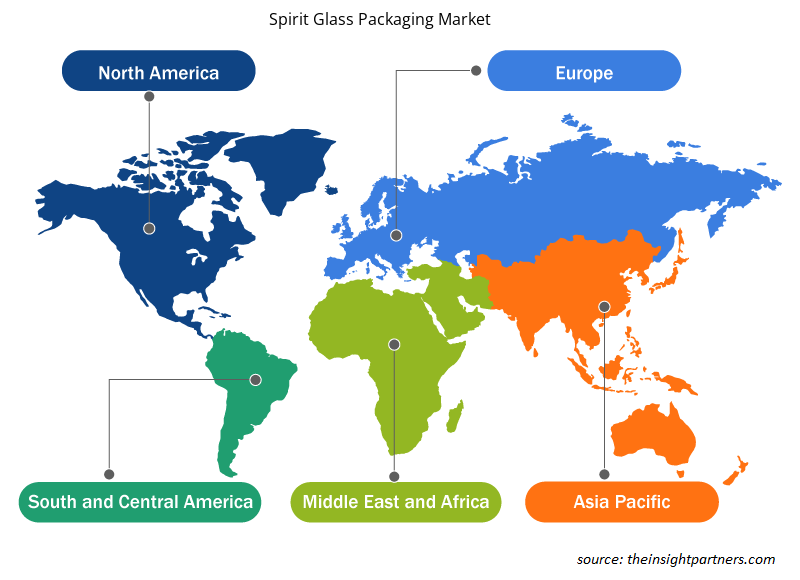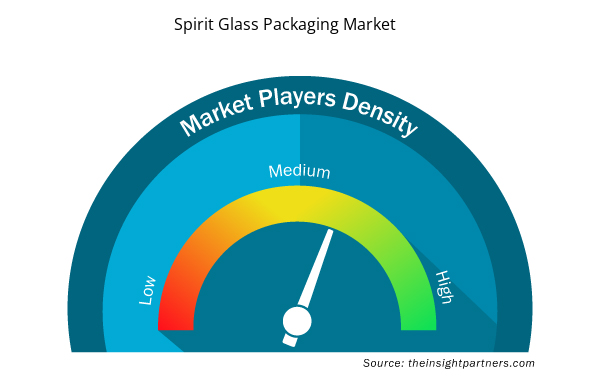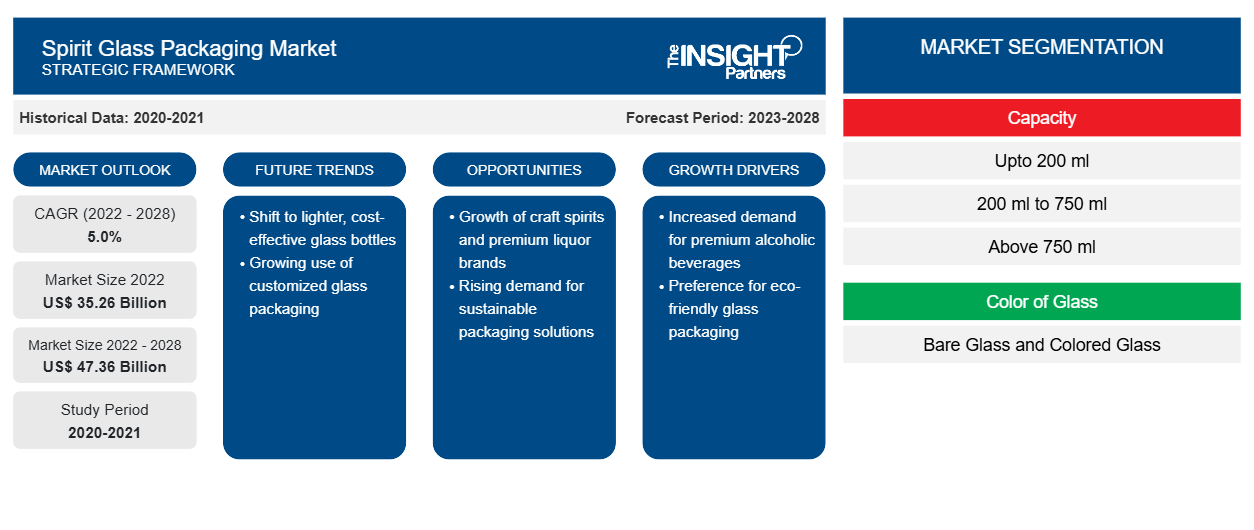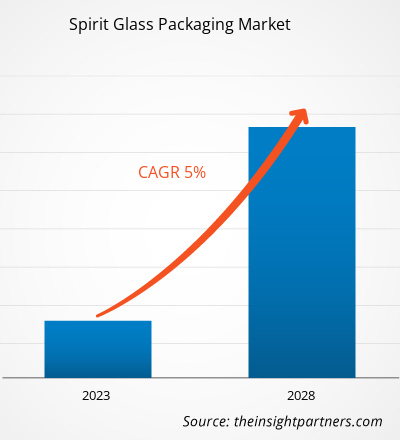[研究报告] 2022 年烈酒玻璃包装市场规模价值 352.5806 亿美元,预计到 2028 年将达到 473.5729 亿美元;预计 2022 年至 2028 年的复合年增长率为 5.0%。
烈酒玻璃包装在烈酒行业中被广泛用于盛放葡萄酒、啤酒、朗姆酒、威士忌和伏特加等烈酒产品。不同烈酒的产品创新,例如调味酒和瓶装混合烈酒的发展,创造了对烈酒玻璃包装的需求。设计独特、颜色各异的玻璃包装增强了整体感官体验,并影响了消费者的购买决策。玻璃包装设计和类型对品牌形象、产品差异化以及产品可接受性和偏好产生积极影响。消费者对玻璃包装的偏好日益增加,这促使烈酒制造商通过包装设计和创新烈酒产品来提供产品差异化。这是因为有厚底、浮雕和装饰的玻璃瓶,再加上标签设计;所有这些特点提供了和谐的高品质品牌形象,并传达了品牌或产品故事。
2022 年,亚太地区占据了全球烈酒玻璃包装市场的最大份额。日本、印度、中国、澳大利亚、韩国、新加坡、台湾和印度尼西亚的市场增长归因于人口酒精消费量的不断增长;偏好从标准啤酒、威士忌、伏特加、葡萄酒和其他烈酒转变为高档啤酒、威士忌、伏特加、葡萄酒和其他烈酒;越来越多的庆祝活动使用酒精饮料;以及该地区烈酒制造商的独特产品创新。例如,2020 年 9 月,新西兰酿酒厂 Scrapegrace Distillery 生产了世界上第一款天然黑杜松子酒(天然黑酿造),由不同寻常的植物混合而成。此外,这种优质杜松子酒与奎宁水混合后会变成红色和紫色。该酿酒厂在 24 小时内售出了三个月的产品供应量。随着产品销量的增加,玻璃包装需求也大幅增长。所有这些因素都促进了该地区烈酒玻璃包装市场的增长。
定制此报告以满足您的需求
您可以免费定制任何报告,包括本报告的部分内容、国家级分析、Excel 数据包,以及为初创企业和大学提供优惠和折扣
- 获取此报告的关键市场趋势。这个免费样品将包括数据分析,从市场趋势到估计和预测。
COVID-19 疫情对烈酒玻璃包装市场的影响
COVID-19 疫情对烈酒玻璃瓶包装市场产生了重大影响。全球封锁以及对旅行和社交聚会的限制导致酒精饮料消费量下降,进而导致烈酒玻璃瓶包装需求下降。许多酒吧、餐馆和酒店(HORECA 行业的主要客户)被迫暂时关闭或减少产能,导致对小尺寸玻璃瓶的需求减少。此外,由于运输和制造业务的限制导致供应链中断,增加了烈酒玻璃瓶包装的生产和分销成本。
2021 年,随着各国政府宣布放宽社会限制,全球市场开始从 2020 年的损失中恢复过来。制造商被允许满负荷生产,这有助于他们克服供需缺口。此外,疫苗接种率的上升也促进了各国总体状况的改善,为工业和商业发展创造了有利的环境。亚太地区和欧洲烈酒产能的提高进一步增加了 2021 年对烈酒玻璃包装的需求。
市场洞察
餐饮、餐饮及娱乐业的增长
HORECA 行业是烈酒玻璃包装的重要终端用户之一。HORECA 是酒店/餐厅/餐饮服务的一部分,包括酒吧、酒馆、啤酒咖啡馆、俱乐部和酒店等。HORECA 对烈酒玻璃包装的影响很大,因为该行业消费的产品数量巨大。全球人口倾向于外出就餐和饮料,可支配收入的增加正在推动全球 HORECA 行业的发展。根据美国国家餐馆协会 (National Restaurant Association) 的数据,全方位服务领域(包括家庭用餐、休闲用餐和高级餐饮全方位服务餐厅)的食品和饮料销售额从 2020 年的 1990 亿美元增长到 2022 年的 2890 亿美元。相比之下,美国有限服务领域(包括快餐店、快速休闲餐厅和自助餐厅)的销售额从 2020 年的 2970 亿美元增长到 2022 年的 3550 亿美元。报告显示,美国酒吧、小酒馆、夜总会或涉及制作和供应酒精饮料的场所的食品和饮料销售额从 2020 年的 130 亿美元增长到 2022 年的 210 亿美元。
容量洞察
根据容量,全球烈酒玻璃包装市场细分为 200 毫升以下、200 毫升至 750 毫升和 750 毫升以上。200 毫升至 750 毫升部分在 2022 年占据了全球烈酒玻璃包装市场份额的最大份额。此类别包括容量为 375 毫升、500 毫升、650 毫升、700 毫升和 750 毫升的玻璃瓶。这些类型的玻璃瓶有各种形状和设计。此外,这些类型的玻璃瓶有不同的颜色,如琥珀棕色、火石白色、祖母绿、绿色、蓝宝石蓝、阳光黄、锭黑色和枪金属色。这些玻璃瓶主要用于包装白兰地、杜松子酒、朗姆酒、龙舌兰酒、伏特加酒、威士忌、葡萄酒、啤酒等。375 毫升和 650 毫升的瓶子主要用于啤酒包装,而 750 毫升的瓶子主要用于威士忌、杜松子酒、朗姆酒、龙舌兰酒和利口酒等烈酒。此外,烈酒玻璃制造商专注于制造各种容量的吸引人的玻璃瓶,这将影响产品价格和消费者的购买行为。
全球烈酒玻璃包装市场的主要参与者包括 OI Glass Inc、Toyo Glass Co Ltd、Ardagh Group SA、Verallia SA、Vidrala SA、Gerresheimer AG、Nihon Yamamura Glass Co Ltd、Vitro SAB de CV、BA Glass BV 和 HEINZ-GLAS GmbH & Co KGaA。全球烈酒玻璃包装市场的参与者专注于提供高质量的产品以满足客户需求。他们还专注于投资研发活动和新产品发布等战略。
报告亮点
- 烈酒玻璃包装市场的渐进式行业趋势可帮助参与者制定有效的长期战略
- 发达市场和发展中市场采用的业务增长战略
- 2020 年至 2028 年烈酒玻璃包装市场定量分析
- 全球烈酒玻璃包装需求量预测
- 波特五力分析说明了行业内买家和供应商的效力
- 了解竞争市场状况的最新发展
- 市场趋势和前景,以及推动和抑制烈酒玻璃包装市场增长的因素
- 通过强调支撑商业利益的市场策略来协助决策过程,从而促进市场增长
- 不同节点的烈酒玻璃包装市场规模
- 市场详细概述和细分,以及烈酒玻璃包装行业动态
- 各地区烈酒玻璃包装市场规模及增长机会
烈酒玻璃包装市场区域洞察
Insight Partners 的分析师已详尽解释了预测期内影响烈酒玻璃包装市场的区域趋势和因素。本节还讨论了北美、欧洲、亚太地区、中东和非洲以及南美和中美洲的烈酒玻璃包装市场细分和地理位置。

- 获取烈酒玻璃包装市场的区域具体数据
烈酒玻璃包装市场报告范围
| 报告属性 | 细节 |
|---|---|
| 2022 年市场规模 | 352.6亿美元 |
| 2028 年市场规模 | 473.6亿美元 |
| 全球复合年增长率(2022 - 2028) | 5.0% |
| 史料 | 2020-2021 |
| 预测期 | 2023-2028 |
| 涵盖的领域 | 按容量
|
| 覆盖地区和国家 | 北美
|
| 市场领导者和主要公司简介 |
|
烈酒玻璃包装市场参与者密度:了解其对业务动态的影响
烈酒玻璃包装市场正在快速增长,这得益于终端用户需求的不断增长,这些需求源于消费者偏好的不断变化、技术进步以及对产品优势的认识不断提高等因素。随着需求的增加,企业正在扩大其产品范围,进行创新以满足消费者的需求,并利用新兴趋势,从而进一步推动市场增长。
市场参与者密度是指在特定市场或行业内运营的企业或公司的分布情况。它表明在给定市场空间中,相对于其规模或总市场价值,有多少竞争对手(市场参与者)存在。
在烈酒玻璃包装市场运营的主要公司有:
- OI 玻璃公司
- 东洋硝子株式会社
- 阿达集团
- 维拉利亚公司
- 维德拉拉公司
免责声明:上面列出的公司没有按照任何特定顺序排列。

- 获取烈酒玻璃包装市场顶级关键参与者概览
全球烈酒玻璃包装市场
根据容量,全球烈酒玻璃包装市场分为 200 毫升以下、200 毫升至 750 毫升和 750 毫升以上。根据玻璃颜色,烈酒玻璃包装市场分为裸玻璃和彩色玻璃。根据用途,烈酒玻璃包装市场分为威士忌、伏特加、朗姆酒、葡萄酒、啤酒和其他。
公司简介
- OI 玻璃公司
- 东洋硝子株式会社
- 阿达集团
- 维拉利亚公司
- 维德拉拉公司
- 格雷斯海姆股份公司
- 日本山村硝子株式会社
- 体外 SAB 法
- BA玻璃公司
- HEINZ-GLAS GmbH & Co KGaA。
- 历史分析(2 年)、基准年、预测(7 年)及复合年增长率
- PEST 和 SWOT 分析
- 市场规模价值/数量 - 全球、区域、国家
- 行业和竞争格局
- Excel 数据集



Report Coverage
Revenue forecast, Company Analysis, Industry landscape, Growth factors, and Trends

Segment Covered
This text is related
to segments covered.

Regional Scope
North America, Europe, Asia Pacific, Middle East & Africa, South & Central America

Country Scope
This text is related
to country scope.
常见问题
Asia Pacific accounted for the largest share of the global spirit glass packaging market. The market growth in Japan, India, China, Australia, South Korea, Singapore, Taiwan, and Indonesia is attributed to growing alcohol consumption among the population; the shift in changing preferences from standard to premium beers, whisky, vodka, wines, and other spirits; increasing number of celebrations with alcoholic beverages; and unusual product innovation by the spirits manufacturers across the region.
Based on capacity, 200 ml to 750 ml segment accounted for the largest revenue share. The growth of the segment is attributed to its usage for the packaging of brandy, gin, rum, tequila, vodka, whiskey, wine, beer, etc. The 375ml and 650 ml bottles are primarily used for beer packaging while, 750 ml bottles are majorly used for spirits such as whisky, gin, rum, tequila, and liqueurs among others.
The major players operating in the global spirit glass packaging market are O-I Glass Inc, Toyo Glass Co Ltd, Ardagh Group SA, Verallia SA, Vidrala SA, Gerresheimer AG, Nihon Yamamura Glass Co Ltd, Vitro SAB de CV, BA Glass BV, and HEINZ-GLAS GmbH & Co KGaA.
Spirit manufacturers globally are focused on investing significantly in innovative packaging solutions to expand their customer base. The innovation in packaging includes distinct design, vibrant colors, detailed labeling, and sustainable packaging. Luxury consumers and whiskey collectors demand distillery upgrades, refurbishments, and novel designs while considering whiskey collection as a form of investment. According to a report published by Scotch Whisky Association in 2023, consumers are attracted to premiumization and high-quality spirits such as scotch whiskey, which is boosting exports of spirits from Scotland. Moreover, changing consumer behavior has prompted spirit manufacturers to increase the customization of bottles, provide innovative glass packaging, and focus on the brand story.
Based on the application, beer segment is projected to register the highest CAGR over the forecast period. Increasing consumer preference for glass packaging has surged the growth of beer segment.
The consumption of spirits is continuously growing across the globe due to rising disposable income, growing favorable demographics, and changing consumer behavior. The high demand for different cocktails has created a trend for premium liquor contained in special glass packaging. The product innovation of different types of spirits, such as flavored liquors and the development of bottled blended spirits, create a demand for spirit glass packaging. Glass packaging design and type positively influences brand image, product differentiation, and product acceptability & preference.
Trends and growth analysis reports related to Chemicals and Materials : READ MORE..
The List of Companies - Spirit Glass Packaging Market
- O-I Glass Inc
- Toyo Glass Co Ltd
- Ardagh Group SA
- Verallia SA
- Vidrala SA
- Gerresheimer AG
- Nihon Yamamura Glass Co Ltd
- Vitro SAB de CV
- BA Glass BV
- HEINZ-GLAS GmbH & Co KGaA.
The Insight Partners performs research in 4 major stages: Data Collection & Secondary Research, Primary Research, Data Analysis and Data Triangulation & Final Review.
- Data Collection and Secondary Research:
As a market research and consulting firm operating from a decade, we have published and advised several client across the globe. First step for any study will start with an assessment of currently available data and insights from existing reports. Further, historical and current market information is collected from Investor Presentations, Annual Reports, SEC Filings, etc., and other information related to company’s performance and market positioning are gathered from Paid Databases (Factiva, Hoovers, and Reuters) and various other publications available in public domain.
Several associations trade associates, technical forums, institutes, societies and organization are accessed to gain technical as well as market related insights through their publications such as research papers, blogs and press releases related to the studies are referred to get cues about the market. Further, white papers, journals, magazines, and other news articles published in last 3 years are scrutinized and analyzed to understand the current market trends.
- Primary Research:
The primarily interview analysis comprise of data obtained from industry participants interview and answers to survey questions gathered by in-house primary team.
For primary research, interviews are conducted with industry experts/CEOs/Marketing Managers/VPs/Subject Matter Experts from both demand and supply side to get a 360-degree view of the market. The primary team conducts several interviews based on the complexity of the markets to understand the various market trends and dynamics which makes research more credible and precise.
A typical research interview fulfils the following functions:
- Provides first-hand information on the market size, market trends, growth trends, competitive landscape, and outlook
- Validates and strengthens in-house secondary research findings
- Develops the analysis team’s expertise and market understanding
Primary research involves email interactions and telephone interviews for each market, category, segment, and sub-segment across geographies. The participants who typically take part in such a process include, but are not limited to:
- Industry participants: VPs, business development managers, market intelligence managers and national sales managers
- Outside experts: Valuation experts, research analysts and key opinion leaders specializing in the electronics and semiconductor industry.
Below is the breakup of our primary respondents by company, designation, and region:

Once we receive the confirmation from primary research sources or primary respondents, we finalize the base year market estimation and forecast the data as per the macroeconomic and microeconomic factors assessed during data collection.
- Data Analysis:
Once data is validated through both secondary as well as primary respondents, we finalize the market estimations by hypothesis formulation and factor analysis at regional and country level.
- Macro-Economic Factor Analysis:
We analyse macroeconomic indicators such the gross domestic product (GDP), increase in the demand for goods and services across industries, technological advancement, regional economic growth, governmental policies, the influence of COVID-19, PEST analysis, and other aspects. This analysis aids in setting benchmarks for various nations/regions and approximating market splits. Additionally, the general trend of the aforementioned components aid in determining the market's development possibilities.
- Country Level Data:
Various factors that are especially aligned to the country are taken into account to determine the market size for a certain area and country, including the presence of vendors, such as headquarters and offices, the country's GDP, demand patterns, and industry growth. To comprehend the market dynamics for the nation, a number of growth variables, inhibitors, application areas, and current market trends are researched. The aforementioned elements aid in determining the country's overall market's growth potential.
- Company Profile:
The “Table of Contents” is formulated by listing and analyzing more than 25 - 30 companies operating in the market ecosystem across geographies. However, we profile only 10 companies as a standard practice in our syndicate reports. These 10 companies comprise leading, emerging, and regional players. Nonetheless, our analysis is not restricted to the 10 listed companies, we also analyze other companies present in the market to develop a holistic view and understand the prevailing trends. The “Company Profiles” section in the report covers key facts, business description, products & services, financial information, SWOT analysis, and key developments. The financial information presented is extracted from the annual reports and official documents of the publicly listed companies. Upon collecting the information for the sections of respective companies, we verify them via various primary sources and then compile the data in respective company profiles. The company level information helps us in deriving the base number as well as in forecasting the market size.
- Developing Base Number:
Aggregation of sales statistics (2020-2022) and macro-economic factor, and other secondary and primary research insights are utilized to arrive at base number and related market shares for 2022. The data gaps are identified in this step and relevant market data is analyzed, collected from paid primary interviews or databases. On finalizing the base year market size, forecasts are developed on the basis of macro-economic, industry and market growth factors and company level analysis.
- Data Triangulation and Final Review:
The market findings and base year market size calculations are validated from supply as well as demand side. Demand side validations are based on macro-economic factor analysis and benchmarks for respective regions and countries. In case of supply side validations, revenues of major companies are estimated (in case not available) based on industry benchmark, approximate number of employees, product portfolio, and primary interviews revenues are gathered. Further revenue from target product/service segment is assessed to avoid overshooting of market statistics. In case of heavy deviations between supply and demand side values, all thes steps are repeated to achieve synchronization.
We follow an iterative model, wherein we share our research findings with Subject Matter Experts (SME’s) and Key Opinion Leaders (KOLs) until consensus view of the market is not formulated – this model negates any drastic deviation in the opinions of experts. Only validated and universally acceptable research findings are quoted in our reports.
We have important check points that we use to validate our research findings – which we call – data triangulation, where we validate the information, we generate from secondary sources with primary interviews and then we re-validate with our internal data bases and Subject matter experts. This comprehensive model enables us to deliver high quality, reliable data in shortest possible time.


 获取此报告的免费样本
获取此报告的免费样本